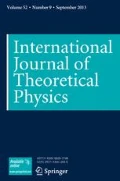Abstract
We present a view where the process of detection of existing reality and creation of new reality is considered explicitly, and that rests on the insight that “the present” is operationally connected to the collection of the “possible” experiences that we can live. We developed a formalism in this view and reality appears as a subtle construction from the reservoir of possible experiences, and see that our consciousness of this construction is lost while many deep problems are related to its presence. We apply the formalism to explain the non-classical probability structures in quantum physics and outline the appearance of topological structures of “the present.” This structuring process is going on actually giving rise to the flow of reality.
Similar content being viewed by others
References
Aerts, D. (1981). The one and the many. Towards a unification of the quantum and classical description of one and many physical entities, Doctoral dissertation, VUB, Brussels.
Aerts, D. (1982). Description of many physical entities without the paradoxes encountered in quantum mechanics,Foundations of Physics,12, 1131.
Aerts, D. (1983). Classical theories and non-classical theories as a special case of a more general theory,Journal of Mathematical Physics,24, 2441.
Aerts, D. (1986). A possible explanation for the probabilities of quantum mechanics,Journal of Mathematical Physics,27, 203.
Aerts, D. (1987). The origin of the non-classical character of the quantum probability model, inInformation Complexity and Control in Quantum Physics, A. Blanquiere, S. Diner, and G. Lochak, eds., Springer-Verlag.
Aerts, D. (1988). The description of separated systems and quantum mechanics and a possible explanation for the probabilities of quantum mechanics, inMicro-physical Reality and Quantum Formalism, A. van der Merweet al., eds., Kluwer.
Aerts, D. (1990a). An attempt to imagine parts of the reality of the micro-world, inProceedings of the Conference “Problems in Quantum Physics; Gdansk '89, Jacek Mizerskiet al., eds., World Scientific, Singapore.
Aerts, D. (1990b). A mechanistic classical laboratory situation violating the Bell inequalities with\(2 \cdot \sqrt 2\), exactly “in the same way” as its violations by the EPR experiments,Helvetica Physica Acta,64, 1.
Aerts, D. (1990c). The construction of reality, TENA, VUB, Brussels.
Aerts, D., and Reignier, J. (1991a). The spin of a quantum entity and problems of non-locality, inProceedings of Symposium on the Foundations of Modern Physics 1990, Pekka Lahtiet al., eds., World Scientific, Singapore.
Aerts, D., and Reignier, J. (1991b). On the problem of non-locality in quantum mechanics,Helvetica Physica Acta,64, 527.
Aerts, D., and Van Bogaert, B. (1992). A mechanistic classical laboratory situation with a quantum logic structure,International Journal of Theoretical Physics, this issue.
Beltrametti, E., and Cassinelli, G. (1981).The Logic of Quantum Mechanics, Addison-Wesley.
Beltrametti, E., and van Fraassen, B. C., eds. (1981).Current Issues in Quantum Logic, Plenum Press, New York.
Einstein, A., Podolsky, B., and Rosen, N. (1935). Can quantum-mechanical description of physical reality be considered complete,Physical Review,47, 777–780.
Feynman, R. (1970).Feynman Lectures in Physics, Vol. 1, Addison-Wesley, Reading, Massachusetts.
Foulis, D. J., and Randall, C. H. (1985). Dirac revisited, inSymposium on the Foundations of Modern Physics 1985, P. Lahti and P. Mittelstaedt, eds., World Scientific, Singapore.
Mittelstaedt, P.,et al., eds. (1985).Recent Developments in Quantum Logic, Bibliographisches Institut, Mannheim.
Piaget, J. (1969).The Child's Conception of Time, Routledge and Kegan, London.
Piaget, J., and Inhelder, B. (1971).The Child's Conception of Space, Routledge and Kegan, London.
Piron, C. (1976).Foundations of Quantum Physics, Benjamin, Reading, Massachusetts.
Piron, C. (1989). Recent developments in quantum mechanics,Helvetica Physica Acta,62, 82.
Piron, C. (1990).Mécanique Quantique, Bases et Applications, Press Polytechnique et Universitaire Romande, Lausanne.
Poincaré, H. (1902).La science et l'hypothèse, Flammarion, Paris.
Randall, C. H., and Foulis, D. J. (1983a). A mathematical language for quantum physics, inLes Fondements de la Mécanique Quantique, C. Gruber, ed., AVCP, Lausanne, pp. 63–148.
Randall, C. H., and Foulis, D. J. (1983b). Properties and operational propositions in quantum mechanics,Foundations of Physics,13, 843.
Schrödinger, E. (1944).What is Life?, Cambridge University Press, Cambridge.
Author information
Authors and Affiliations
Rights and permissions
About this article
Cite this article
Aerts, D. Construction of reality and its influence on the understanding of quantum structures. Int J Theor Phys 31, 1815–1837 (1992). https://doi.org/10.1007/BF00678294
Received:
Issue Date:
DOI: https://doi.org/10.1007/BF00678294




